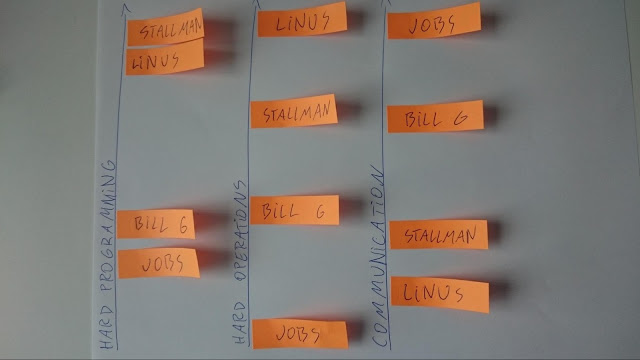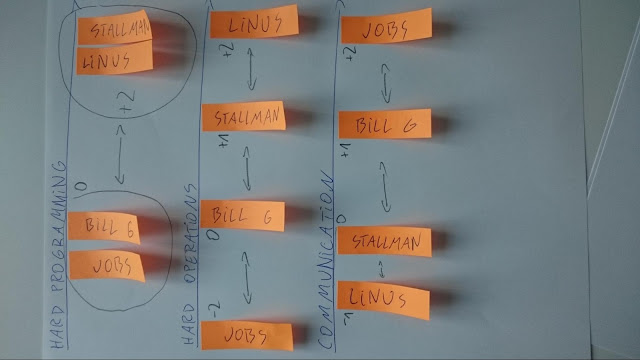How and why did I implement the P2P survey for the calculation of salaries in a corporation: a concrete example
Translation of the P2P Salary Review material.

')
The CEO of the company raised the minimum wage in the company to £ 45,000, and some employees left the company because of this . Do you know why? Because the educated people who are stuck in, refused to accept the fact that ordinary hard workers who did not invest in their development began to receive so much time and money.
The interesting thing about wages and what makes people happy is that the absolute amount is less important than the relative amount in the system. And this is a little non-intuitive.
Imagine: when hard times come, war, economic crisis, many people calmly bear the burden, because they know that everything is in the same situation. On the other hand, people do not accept when they see that stupid, incompetent people drive expensive cars and live in luxurious homes.
Honesty is the most important aspect of any payroll system. Honesty is what we optimize for.
Keep in mind that your company is part of a large system (industry). This system does not matter how fair you are, but you cannot underpay your people. You must be honest and competitive. Otherwise, justice will prevail, which is called “find a better job” and will punish you.

It's pretty easy to rate the people who work with you when you have a team of five people. But as soon as there are more than seven of them, you only have to guess what people are doing. A level below, after forty-nine, you simply have no chance.
When I started, I managed twelve employees, and we grew to fifty, I immediately realized that I did not want to evaluate everyone. It will simply be dishonest, wrong and will still take a lot of time.
People are divided into small self-organizing groups. You must give them the opportunity to evaluate each other, for each of the specific roles, such as Team Lead, Product Owner or Scrum Master. Be that as it may, Scrum Master and Product Owner do not have enough technical expertise to evaluate the developer correctly. They focus on soft skills, which is only half of the picture. Team Leader looks just in the opposite direction. And what happens is that I still have to evaluate these “special” roles.
And the biggest problem is that as soon as you place the authority to control wages in the hands of another person, you can no longer apply the same approach to it. Thus, my self-organized team will be to the "Project Manager, with their minions."
This is the good old way of a centralized management style with reporting control, lack of trust and cooperation.
“I also noticed that different countries and cultures put different values at the forefront.” Some, like the UK, value control and restraint, while others (like Scandinavia) value freedom and initiative. "[Software Architecture for Developers; Simon Brown; Leanpub 2014]
I do not like it. This is very unproductive.
If not a Product Owner, not a Scrum Master, and definitely not a manager, then who can make an assessment? Who can guarantee that people work hard, efficiently, competently and valuablely for a company?
Theoretically, our customers or the market can reflect this. We can analyze whether people make a profit, or help us get closer to our goal. Unfortunately, this can work only if the team can determine what exactly this employee is working on and what kind of business opportunities it opens up. But even then, it will probably not be fair.
You should not punish people for taking risks or making mistakes. You want them to not be afraid to experiment, make mistakes and learn from this. At least until they destroy your business. If they want to experiment at this level, then let them do it with their business.
I work in a corporation. Decisions about the products we produce are made at the Executive Committee level. Evaluating my developers based on profit will not be fair.

Only one option remains. P2P, - comparison of each each. We have a system where everyone has some idea and predisposition, but no one sees the full picture. Let's collect all the data together, analyze and try to extract from what we need.
For employees, the whole process can take more than 30 minutes, but if possible, in most cases, no longer than 15. And this is for the evaluation of ALL employees. Otherwise, the price is huge because everyone has to go through this procedure (and this is boring).
For a manager, the collection and analysis of information should not take more than one day.
you need to make it difficult to deceive the system (since we have pretty tricky guys here).
It would be nice if the system gave us something more than the level of salaries. It would be great if the system told our employees what they should do in order to earn more. As much as possible.

Great, we have limitations. What exactly are we measuring?
How do people stick? This is not an end in itself. I do not want people to burn out at work. This is software development. This is a creative work, and I want them to be first and foremost professionals in this.
Results? What kind? Companies? That is, the money, as we have already discussed, does not work. Individual results? As we said, they just make people work more, not better, and we don't want that. Devotion? This will make all loyal idiots rich, but it will not help us.
How about evaluating the effect of an individual individual on a company? Has the meaning? If we measure influence and tie it to money, the system must be honest.
Do you work hard every day to move the company forward? Do you educate yourself because you are self-motivated? Is your production code? Get it, sign it.
You smack the whole day, but a brilliant idea visits you in the evening, do you implement it in the morning, does it solve a lot of problems for everyone and allows you to achieve a result?
Why not? Want, no problem. Just take a shower. And then do whatever you want with your money.
You are a genius, your ego is about the size of a planet, you are reading the right books, can you move mountains thanks to your knowledge and expertise? Do you have a doctoral degree in agile and a jet-node.js-express expert, but you cannot work with the people who surround you and roll out your super ideas into production? Are you disturbing the team? People don't want to work with you? Sorry, but there is no influence, or even negative. No money
Well, but the assessment of the real impact is quite complicated. Even more, it probably will not be fair. This is a team sport and the best people may not be so good in the eyes of unproductive employees, as a result of some business changes, you know, “shit happens”. Real influence, as well as profit estimation, will not be fair, and then, the best people suffer due to circumstances over which they have no control.
This problem is also a solution. You must measure the potential impact (without envious ones), and check their actual experience (because your feeling may differ from the results obtained), look for and correct situations where the potential is not used.

How to measure the potential impact of someone? In IT, potential influence is based on skills. The better the skills, the higher the potential impact, and not all skills are equivalent. How to adequately measure skills at a reasonable time?
Fortunately, I have already solved this problem once. In the process of recruiting in TouK, when I spent days on days paired with other programmers (an excellent, but rather expensive way), I came to the conclusion that in order to give recommendations on salary, I want to compare new people with those who know six skill groups that I suppose are important for software development.
This may be a surprise, but hard skills are only a third. From my experience, most developers can do very complex things with enough time. But the problem is that many of them tend to focus on one problem to miss the rest (self-sufficiency), for some I just cannot allow “enough time”, many will not be able to share their knowledge with colleagues.
Yes, alas, but IT is not only about programming. At least you should work as a team. Programming is a basic skill, but not the only one.
What is great is that with the exception of two groups of hard skills, you can also just rate Product Owners and Scrum Masters. What makes the whole process easier and more holistic.
People are not very well compared in absolute terms. But we compare very well. In the first iteration, I drew lines for each of the skills and sculpted stickers with names relative to each other (from the bottom — worse, from the top — better). No absolute numbers.
Since you do not work with everyone, you should evaluate only those people whom you can, and only if you can evaluate these skills.
The result looks something like this:

Great, we have some data. Time to filter the noise.
After that, I would like to take each separately, and ask them to clarify their own picture. We can talk about “neighbors” being 20% above and below.
About all problems with other people (as a rule, communication). He asked how people's assessments could improve their situation. Collected reviews.
Then I normalized and clustered the results with values of -2 .. + 2. Like this:

Manual normalization and clustering of data took a lot of time even for twenty people.
Another time I decided to use absolute values from 0 to 4 and use google forms to collect reviews. I was afraid that without constant scaling, people would have problems with comparison. It turned out in vain. This is IT. People have no problem understanding clustering. Discrete values work fine.
I also added a field with notes for each of the skills, so people could describe their thoughts on the top-bottom 20%.

The field, "who has a similar skill ..." is here to help test your feelings.
However, I held one-on-one meetings with everyone. A fully automated system would easily be "deceived." The system where you have to give your assessment to another person is harder to break. Much more animated. Thus, while my people did the data clustering automatically, I did the normalization and checks myself.
So what do we have at the end? A bunch of numbers.

Each column is an employee. Each row is a level. Each cell displays voices for the transferred skill set at a certain level. Color depends on the value, which allows you to quickly notice the peak values.
A simple formula in excel and you have a number for each skill set, for each employee. You can even sum up and get one metric. This metric reflects the "star". How good is the employee, right?
While the numbers look good. Need to analyze the distribution. why does this guy hate all but three people? Who are these people? What is the working relationship between them? Why are these three poorly rated in this skill? Why others do not have a rating in Focus & Motivation? Is he proactive? Aggressively passive? What about this girl, is she good at everything except DevOps? Does it still work on windows?
I do not know if it is possible to automate this, but I do not even want to try. Distribution tells you stories. When you add additional verbal or written feedback, you get an understanding of the dynamics of your team better.
You can always ask. If you want to dig deeper, you can. The beauty of that system is that you know where to dig. Understanding the situation plays a big role in the normalization of feedback.

Skills are based on potential recall. But what about the girl who never complains about the work, does not panic even in critical situations, with the work for which no one wants to take, but it must be done. You will hear only a quiet sigh, and the work will be done. This is useful. It calms down. Her attitude, polite voice and behavior makes the guys worry, in difficult times. It is very important for the company.
But this is not rated in the P2P survey.
This is because Influence and P2P polls do not show the same thing.
To simplify this, my influence formula looks like this:
Impact = normalized P2P survey + personal qualities
The qualities are simple. They can be negative or positive. How much examples to make it clearer:
+ Performance / Security - the expertise that is needed once a year
+ Public Relations (blog, open source library, attracts good developers to us)
+ Assertiveness / assertiveness (helps to maintain quality at a high level)
- Submissiveness / Submission (the client may put pressure on him, leading to a problem)
+ Iron Willpower / Iron Will (does not break, regardless of the situation)
- Low Willpower / Weak Will (alarmist)
You should easily recognize yourself. It's like a good role-playing game, the qualities determine the character. I know a lot of good developers, but what distinguishes them from others is their interests and qualities.
Qualities change the result of clustering skills. They usually add or subtract one to the final result.
Now back to our original goal, honest payroll. We have a cluster of skills modified by the qualities inherent to our employees, describing the potential influence of an employee on the company. On the other hand, we found a lot of interesting information about the dynamics of teams and other, not obvious things. Now we need to bring numbers to a single assessment, a cluster. People in this cluster have the same influence. It's time to correlate these values with money.
The problem with many corporations is that salaries are not publicly available. At least officially. It remains of the remnants of an era when an employer should want to pay his employees as little as possible. What's the point of this? Why do I, as an employee have to pay as little as possible? The goal of each employee is to earn as much as possible, if I pay more to demand more, everything becomes more logical. It makes no sense to pay less. And to look for a middle ground in which the money that the employee receives, gives him maximum benefits, makes sense.
Some will disagree, saying that money is not a motivator, after some amount. It's true. Notch, the author of minecraft, with all its billions of euros, is not very worried about how to earn another million. But it must be admitted that he is not a standard worker, and people who say that this is not a motivator usually already have a lot. Let's look at the developer market, most of them are also motivated by money. This is not the only, but an important factor forcing people to change jobs. Anyone with children will confirm this.
So, what can we do in a corporation where we cannot disclose salaries?
We cannot publish salaries, but we can publish, in a way, a starting point. There are a lot of sites that publish ads with salaries or salary forks (for example, nofluffjobs.com). If you have identified 5 different clusters, you can probably link them to posts in some way (junior developer, architect, senior architect, senior executive executive architect, etc.)
Now, all you need to do is publish these job offers with salaries (fixed or forks) and people can compare their situation with the whole picture.
Now, if you always associate salaries with posts and potential influence. Ensure openness and transparency. And now, since the posts are open, salaries are also becoming obvious.
More or less. More if you have only one digit falls into a cluster, less if it is a range. One way or another, people will see the whole picture and let them know if it is not fair enough.
To be consistent, I dismissed someone who received much more than he should have been in his position (that is, could bargain better than work), and raised wages to all who did not bargain for them but were good. If it matters to you how employees bargain for wages, just put it in a separate quality.

The system has advantages and disadvantages. First of all, dignity.
I do not have to be a judge. I do not have to play the role of "master of fate." As soon as people understand that they should not make a good impression on me, this significantly changes the essence of our cooperation. This makes them more open.
People don't want to convince me when they need a pay rise. They must convince their colleagues of this. This means that we are free to discuss what needs to be improved in order to increase their potential influence in the company or to improve skills. Or the perception of their skills by other people. When someone thinks that his skills are far beyond his grades by other people, it is often a communication problem. Ego or ego. This is something that we can change. However, this situation is more complicated. But even so, at least you have the information.
If this is a communication problem, it is no longer "my boss does not love me." Now this, "look, your colleagues say that you do not know how to communicate with them." you can't ignore all these people. You can't even get mad at these people. Ultimately, you understand - the problem is with you.
It takes 15 minutes for a developer, one day for a manager. On average, because it depends on how deeply you want to look into the rabbit hole.
After analyzing, it gives you a ton of information that can be used for feedback from people. And people want to hear feedback. I did this every half year, because in a corporation we have a review of salaries in the summer and a review of bonuses in the winter. People even asked me to do this more often, realizing that this would not affect anything, but they wanted to know the feedback about their work. The more feedback, the better.
And this can be applied to developers, managers, testers, system administrators ... Anyone who has colleagues.

There is always a fly in the ointment.
P2P survey does not work for people who work themselves. This does not work if your team is static, and has remained in the same lineup for years. But if this is a medium-sized company, people do not communicate between teams, do not share knowledge, then probably you need to solve another problem.
The mistake is to simply turn people into numbers. Do not do this. Let the distribution tell you stories and explore them. Otherwise, your system will be dishonest, and dishonest systems are easy to fool. This, a kind of social justice, I suppose.
You cannot compare salaries between different roles (QA / dev / PO) since these are different levels in the market. This is not so bad, but since you promised to be honest, what will happen if someone changes their position from more paid to less paid? Scrum Master for example go to Product Owner? Especially if it continues to fulfill its responsibilities (the potential impact remains high), but what if not?
Or how about the fact that some do not learn anything new for years? In a rapidly changing programming world, skills become obsolete even faster.
Sometimes, in order for the system to remain fair, you have to fire someone.
It is also quite difficult to explain to non-IT people (CEO, HR) that someone can improve by + 40% per year. They are simply not ready to raise their salaries so dynamically. But it happens in IT.
Another mistake I made was that I didn't give enough points of reference. I published only two forks of salaries, for middle and senior, due to the fact that it was not easy to change in our corporation. At the same time, I had 5 clusters from the P2P poll. Some new people in the senior position expected a higher score. In fact, 70% of highly qualified professionals were at the beginning of this salary range. My clusters and published “points of reference” were not “everyone to everyone,” and this confused people a little. Fortunately, people trust me enough that this is not a problem. I just had to clear up such moments a little.
But all this is nonsense compared to the advantages of the P2P survey.
And most importantly - this system has been working for two years now and people like it.
At least the overwhelming amount of feedback I received. And that makes me happy.
How and why did I implement the P2P survey for the calculation of salaries in a corporation: a concrete example
Purpose: fair optimization

')
The CEO of the company raised the minimum wage in the company to £ 45,000, and some employees left the company because of this . Do you know why? Because the educated people who are stuck in, refused to accept the fact that ordinary hard workers who did not invest in their development began to receive so much time and money.
The interesting thing about wages and what makes people happy is that the absolute amount is less important than the relative amount in the system. And this is a little non-intuitive.
Imagine: when hard times come, war, economic crisis, many people calmly bear the burden, because they know that everything is in the same situation. On the other hand, people do not accept when they see that stupid, incompetent people drive expensive cars and live in luxurious homes.
Honesty is the most important aspect of any payroll system. Honesty is what we optimize for.
Keep in mind that your company is part of a large system (industry). This system does not matter how fair you are, but you cannot underpay your people. You must be honest and competitive. Otherwise, justice will prevail, which is called “find a better job” and will punish you.
Awareness of their ignorance

It's pretty easy to rate the people who work with you when you have a team of five people. But as soon as there are more than seven of them, you only have to guess what people are doing. A level below, after forty-nine, you simply have no chance.
When I started, I managed twelve employees, and we grew to fifty, I immediately realized that I did not want to evaluate everyone. It will simply be dishonest, wrong and will still take a lot of time.
What options do I have?
People are divided into small self-organizing groups. You must give them the opportunity to evaluate each other, for each of the specific roles, such as Team Lead, Product Owner or Scrum Master. Be that as it may, Scrum Master and Product Owner do not have enough technical expertise to evaluate the developer correctly. They focus on soft skills, which is only half of the picture. Team Leader looks just in the opposite direction. And what happens is that I still have to evaluate these “special” roles.
And the biggest problem is that as soon as you place the authority to control wages in the hands of another person, you can no longer apply the same approach to it. Thus, my self-organized team will be to the "Project Manager, with their minions."
This is the good old way of a centralized management style with reporting control, lack of trust and cooperation.
“I also noticed that different countries and cultures put different values at the forefront.” Some, like the UK, value control and restraint, while others (like Scandinavia) value freedom and initiative. "[Software Architecture for Developers; Simon Brown; Leanpub 2014]
I do not like it. This is very unproductive.
Customer, market and shareholders
If not a Product Owner, not a Scrum Master, and definitely not a manager, then who can make an assessment? Who can guarantee that people work hard, efficiently, competently and valuablely for a company?
Theoretically, our customers or the market can reflect this. We can analyze whether people make a profit, or help us get closer to our goal. Unfortunately, this can work only if the team can determine what exactly this employee is working on and what kind of business opportunities it opens up. But even then, it will probably not be fair.
You should not punish people for taking risks or making mistakes. You want them to not be afraid to experiment, make mistakes and learn from this. At least until they destroy your business. If they want to experiment at this level, then let them do it with their business.
I work in a corporation. Decisions about the products we produce are made at the Executive Committee level. Evaluating my developers based on profit will not be fair.
P2P

Only one option remains. P2P, - comparison of each each. We have a system where everyone has some idea and predisposition, but no one sees the full picture. Let's collect all the data together, analyze and try to extract from what we need.
Our limitations
For employees, the whole process can take more than 30 minutes, but if possible, in most cases, no longer than 15. And this is for the evaluation of ALL employees. Otherwise, the price is huge because everyone has to go through this procedure (and this is boring).
For a manager, the collection and analysis of information should not take more than one day.
you need to make it difficult to deceive the system (since we have pretty tricky guys here).
It would be nice if the system gave us something more than the level of salaries. It would be great if the system told our employees what they should do in order to earn more. As much as possible.
Influence

Great, we have limitations. What exactly are we measuring?
How do people stick? This is not an end in itself. I do not want people to burn out at work. This is software development. This is a creative work, and I want them to be first and foremost professionals in this.
Results? What kind? Companies? That is, the money, as we have already discussed, does not work. Individual results? As we said, they just make people work more, not better, and we don't want that. Devotion? This will make all loyal idiots rich, but it will not help us.
How about evaluating the effect of an individual individual on a company? Has the meaning? If we measure influence and tie it to money, the system must be honest.
Do you work hard every day to move the company forward? Do you educate yourself because you are self-motivated? Is your production code? Get it, sign it.
You smack the whole day, but a brilliant idea visits you in the evening, do you implement it in the morning, does it solve a lot of problems for everyone and allows you to achieve a result?
Why not? Want, no problem. Just take a shower. And then do whatever you want with your money.
You are a genius, your ego is about the size of a planet, you are reading the right books, can you move mountains thanks to your knowledge and expertise? Do you have a doctoral degree in agile and a jet-node.js-express expert, but you cannot work with the people who surround you and roll out your super ideas into production? Are you disturbing the team? People don't want to work with you? Sorry, but there is no influence, or even negative. No money
Well, but the assessment of the real impact is quite complicated. Even more, it probably will not be fair. This is a team sport and the best people may not be so good in the eyes of unproductive employees, as a result of some business changes, you know, “shit happens”. Real influence, as well as profit estimation, will not be fair, and then, the best people suffer due to circumstances over which they have no control.
This problem is also a solution. You must measure the potential impact (without envious ones), and check their actual experience (because your feeling may differ from the results obtained), look for and correct situations where the potential is not used.
Skills

How to measure the potential impact of someone? In IT, potential influence is based on skills. The better the skills, the higher the potential impact, and not all skills are equivalent. How to adequately measure skills at a reasonable time?
Fortunately, I have already solved this problem once. In the process of recruiting in TouK, when I spent days on days paired with other programmers (an excellent, but rather expensive way), I came to the conclusion that in order to give recommendations on salary, I want to compare new people with those who know six skill groups that I suppose are important for software development.
Groups
- Hard Programming Skills (includes knowledge of programming languages, OOP / FP, frameworks, methodologies like XP, TDD, DDD, etc.)
- Hard DevOps Skills (including: Linux administration, deployment / build pipelines, JVM / GC tuning, database tuning, etc.)
- Communication (How easy is it to interact? Do you like working with this person? Does this guy annoy you? Does he / she know how to read your mind?)
- Understanding (How fast is understanding new, complex pieces. How fast is learning?)
- Self-sufficiency (Can I do everything myself or need help and control? Can I just give him the problem and get the result? This includes an understanding of the domain, a broad outlook, a result orientation, self-analysis and ability to adapt)
- Focus & Motivation (Some people can move mountains with their willpower. They are self-motivated. You just remove the barriers from their path and let them do their job.
Others are more diffuse, lack of self-motivation or meaning, need to indicate direction, are prone to procrastination, or in the worst case, require constant monitoring and a large number of reports)
This may be a surprise, but hard skills are only a third. From my experience, most developers can do very complex things with enough time. But the problem is that many of them tend to focus on one problem to miss the rest (self-sufficiency), for some I just cannot allow “enough time”, many will not be able to share their knowledge with colleagues.
Yes, alas, but IT is not only about programming. At least you should work as a team. Programming is a basic skill, but not the only one.
What is great is that with the exception of two groups of hard skills, you can also just rate Product Owners and Scrum Masters. What makes the whole process easier and more holistic.
Stage 1. Comparison.
People are not very well compared in absolute terms. But we compare very well. In the first iteration, I drew lines for each of the skills and sculpted stickers with names relative to each other (from the bottom — worse, from the top — better). No absolute numbers.
Since you do not work with everyone, you should evaluate only those people whom you can, and only if you can evaluate these skills.
The result looks something like this:

Great, we have some data. Time to filter the noise.
Stage 2: Draft and finishing data processing.
After that, I would like to take each separately, and ask them to clarify their own picture. We can talk about “neighbors” being 20% above and below.
About all problems with other people (as a rule, communication). He asked how people's assessments could improve their situation. Collected reviews.
Then I normalized and clustered the results with values of -2 .. + 2. Like this:

Manual normalization and clustering of data took a lot of time even for twenty people.
Another time I decided to use absolute values from 0 to 4 and use google forms to collect reviews. I was afraid that without constant scaling, people would have problems with comparison. It turned out in vain. This is IT. People have no problem understanding clustering. Discrete values work fine.
I also added a field with notes for each of the skills, so people could describe their thoughts on the top-bottom 20%.

The field, "who has a similar skill ..." is here to help test your feelings.
However, I held one-on-one meetings with everyone. A fully automated system would easily be "deceived." The system where you have to give your assessment to another person is harder to break. Much more animated. Thus, while my people did the data clustering automatically, I did the normalization and checks myself.
Stage 3: Data Analysis.
So what do we have at the end? A bunch of numbers.

Each column is an employee. Each row is a level. Each cell displays voices for the transferred skill set at a certain level. Color depends on the value, which allows you to quickly notice the peak values.
A simple formula in excel and you have a number for each skill set, for each employee. You can even sum up and get one metric. This metric reflects the "star". How good is the employee, right?
Not so fast
While the numbers look good. Need to analyze the distribution. why does this guy hate all but three people? Who are these people? What is the working relationship between them? Why are these three poorly rated in this skill? Why others do not have a rating in Focus & Motivation? Is he proactive? Aggressively passive? What about this girl, is she good at everything except DevOps? Does it still work on windows?
I do not know if it is possible to automate this, but I do not even want to try. Distribution tells you stories. When you add additional verbal or written feedback, you get an understanding of the dynamics of your team better.
You can always ask. If you want to dig deeper, you can. The beauty of that system is that you know where to dig. Understanding the situation plays a big role in the normalization of feedback.
Impact! = P2P poll

Skills are based on potential recall. But what about the girl who never complains about the work, does not panic even in critical situations, with the work for which no one wants to take, but it must be done. You will hear only a quiet sigh, and the work will be done. This is useful. It calms down. Her attitude, polite voice and behavior makes the guys worry, in difficult times. It is very important for the company.
But this is not rated in the P2P survey.
This is because Influence and P2P polls do not show the same thing.
To simplify this, my influence formula looks like this:
Impact = normalized P2P survey + personal qualities
Qualities
The qualities are simple. They can be negative or positive. How much examples to make it clearer:
+ Performance / Security - the expertise that is needed once a year
+ Public Relations (blog, open source library, attracts good developers to us)
+ Assertiveness / assertiveness (helps to maintain quality at a high level)
- Submissiveness / Submission (the client may put pressure on him, leading to a problem)
+ Iron Willpower / Iron Will (does not break, regardless of the situation)
- Low Willpower / Weak Will (alarmist)
You should easily recognize yourself. It's like a good role-playing game, the qualities determine the character. I know a lot of good developers, but what distinguishes them from others is their interests and qualities.
Qualities change the result of clustering skills. They usually add or subtract one to the final result.
Relationship with salary
Now back to our original goal, honest payroll. We have a cluster of skills modified by the qualities inherent to our employees, describing the potential influence of an employee on the company. On the other hand, we found a lot of interesting information about the dynamics of teams and other, not obvious things. Now we need to bring numbers to a single assessment, a cluster. People in this cluster have the same influence. It's time to correlate these values with money.
The problem with many corporations is that salaries are not publicly available. At least officially. It remains of the remnants of an era when an employer should want to pay his employees as little as possible. What's the point of this? Why do I, as an employee have to pay as little as possible? The goal of each employee is to earn as much as possible, if I pay more to demand more, everything becomes more logical. It makes no sense to pay less. And to look for a middle ground in which the money that the employee receives, gives him maximum benefits, makes sense.
Some will disagree, saying that money is not a motivator, after some amount. It's true. Notch, the author of minecraft, with all its billions of euros, is not very worried about how to earn another million. But it must be admitted that he is not a standard worker, and people who say that this is not a motivator usually already have a lot. Let's look at the developer market, most of them are also motivated by money. This is not the only, but an important factor forcing people to change jobs. Anyone with children will confirm this.
So, what can we do in a corporation where we cannot disclose salaries?
We cannot publish salaries, but we can publish, in a way, a starting point. There are a lot of sites that publish ads with salaries or salary forks (for example, nofluffjobs.com). If you have identified 5 different clusters, you can probably link them to posts in some way (junior developer, architect, senior architect, senior executive executive architect, etc.)
Now, all you need to do is publish these job offers with salaries (fixed or forks) and people can compare their situation with the whole picture.
Now, if you always associate salaries with posts and potential influence. Ensure openness and transparency. And now, since the posts are open, salaries are also becoming obvious.
More or less. More if you have only one digit falls into a cluster, less if it is a range. One way or another, people will see the whole picture and let them know if it is not fair enough.
To be consistent, I dismissed someone who received much more than he should have been in his position (that is, could bargain better than work), and raised wages to all who did not bargain for them but were good. If it matters to you how employees bargain for wages, just put it in a separate quality.
Benefit

The system has advantages and disadvantages. First of all, dignity.
I do not have to be a judge. I do not have to play the role of "master of fate." As soon as people understand that they should not make a good impression on me, this significantly changes the essence of our cooperation. This makes them more open.
People don't want to convince me when they need a pay rise. They must convince their colleagues of this. This means that we are free to discuss what needs to be improved in order to increase their potential influence in the company or to improve skills. Or the perception of their skills by other people. When someone thinks that his skills are far beyond his grades by other people, it is often a communication problem. Ego or ego. This is something that we can change. However, this situation is more complicated. But even so, at least you have the information.
If this is a communication problem, it is no longer "my boss does not love me." Now this, "look, your colleagues say that you do not know how to communicate with them." you can't ignore all these people. You can't even get mad at these people. Ultimately, you understand - the problem is with you.
It takes 15 minutes for a developer, one day for a manager. On average, because it depends on how deeply you want to look into the rabbit hole.
After analyzing, it gives you a ton of information that can be used for feedback from people. And people want to hear feedback. I did this every half year, because in a corporation we have a review of salaries in the summer and a review of bonuses in the winter. People even asked me to do this more often, realizing that this would not affect anything, but they wanted to know the feedback about their work. The more feedback, the better.
And this can be applied to developers, managers, testers, system administrators ... Anyone who has colleagues.
disadvantages

There is always a fly in the ointment.
P2P survey does not work for people who work themselves. This does not work if your team is static, and has remained in the same lineup for years. But if this is a medium-sized company, people do not communicate between teams, do not share knowledge, then probably you need to solve another problem.
The mistake is to simply turn people into numbers. Do not do this. Let the distribution tell you stories and explore them. Otherwise, your system will be dishonest, and dishonest systems are easy to fool. This, a kind of social justice, I suppose.
You cannot compare salaries between different roles (QA / dev / PO) since these are different levels in the market. This is not so bad, but since you promised to be honest, what will happen if someone changes their position from more paid to less paid? Scrum Master for example go to Product Owner? Especially if it continues to fulfill its responsibilities (the potential impact remains high), but what if not?
Or how about the fact that some do not learn anything new for years? In a rapidly changing programming world, skills become obsolete even faster.
Sometimes, in order for the system to remain fair, you have to fire someone.
It is also quite difficult to explain to non-IT people (CEO, HR) that someone can improve by + 40% per year. They are simply not ready to raise their salaries so dynamically. But it happens in IT.
Another mistake I made was that I didn't give enough points of reference. I published only two forks of salaries, for middle and senior, due to the fact that it was not easy to change in our corporation. At the same time, I had 5 clusters from the P2P poll. Some new people in the senior position expected a higher score. In fact, 70% of highly qualified professionals were at the beginning of this salary range. My clusters and published “points of reference” were not “everyone to everyone,” and this confused people a little. Fortunately, people trust me enough that this is not a problem. I just had to clear up such moments a little.
But all this is nonsense compared to the advantages of the P2P survey.
And most importantly - this system has been working for two years now and people like it.
At least the overwhelming amount of feedback I received. And that makes me happy.
Source: https://habr.com/ru/post/296268/
All Articles